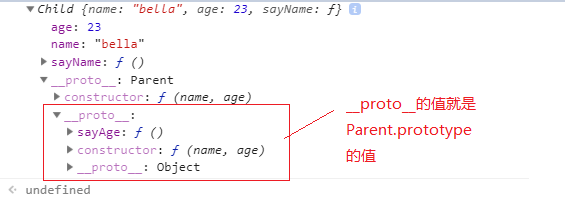js继承实现
在js里面,继承总是晦涩难懂的。那让我们一步一步来分析js继承。
首先,继承的目的。我们可以通过new一个构造器的实例对象,就可以实现调用父类的所有的方法。根本不需要propotype之类的。
来段代码理解下:
var Person = function(name, age) { this.name = name; this.age = age; this.sayName = function() { console.log(this.name); }; }; var person1 = new Person("bella", 23); console.log(person1);

这里没有用到prototype,person1对象可以直接调用Person构造器中的属性和方法。
那我们为什么要用到prototype呢?说明通过new一个实例对象的方法是存在缺陷的 。那我们就来分析下,这个缺陷到底是什么?
var Person = function(name, age) { this.name = name; this.age = age; this.sayName = function() { console.log(this.name); }; }; var person1 = new Person("bella", 23); var person2 = new Person("alex", 2); console.log(person1); console.log(person2); console.log(person1.sayName === person2.sayName);

我们可以看到person1.sayName 不等于person2.name。意味着person1复制了一份sayName,person2也复制了一份sayName. 这样就比较消耗内存了。
于是我们想要person1和person2两个调用的时同一个sayName,像引用对象一样,调用同一个引用。
于是就引出了prototype,__proto__,原型链。如果这些知识不懂,先自行搞懂这些。
我们打印下person1对象,都有哪些东东?

可以看到有age,name,sayName除外,还有__proto__隐式原型。
__proto__里面有constructor 和__proto__.那我们就着重看下这个construtor和__proto__
每个对象都有个__proto__。__proto__.constructor又指向自己,相当于__proto__.constructor = Person;
__proto__.__proto__ = Person.prototype
那如果实现继承需要实现什么?
一个Parent构造器和一个Child构造器。然后Child继承Person,需要实现什么?
第一步,肯定需要实现Person构造器里面的。
.call(this);
第二步,就是通过原型链的原理实现,继承父类原型上的属性和方法。
Child子类的prototype 里面有constructor和__proto__属性。
那么继承原理就是:
Child.prototype.constructor = Child;
Child.prototype.__proto__ = Parent.prototype;
这样Child就可以通过原型链找到Parent原型上的方法了。
所以原理就是第一步和第二步里面标红的3行代码了。
实现如下:
var Parent = function(name, age) { this.name = name; this.age = age; this.sayName = function() { console.log(this.name); }; }; Parent.prototype.sayAge = function() { console.log(this.age); }; var Child = function(name, age) { Parent.call(this, name, age); }; Child.prototype.__proto__ = Parent.prototype; Child.prototype.constructor = Child; var child = new Child("bella", 23); console.log(child);
输出结果:

但是js里面一般不直接操作__proto__属性,所以有了更优化的方案。
var Parent = function(name, age) { this.name = name; this.age = age; this.sayName = function() { console.log(this.name); }; }; Parent.prototype.sayAge = function() { console.log(this.age); }; var Child = function(name, age) { Parent.call(this, name, age); }; var Temp = function() {}; Temp.prototype = Parent.prototype; var temp = new Temp(); temp.constructor = Child; Child.prototype = temp; // Child.prototype.__proto__ = Parent.prototype; // Child.prototype.constructor = Child; var child = new Parent("bella", 23); console.log(child);
标红部分就是优化之后的代码。很多看着会一脸懵。为什么这个算是优化的?我怎么看不懂。
需要看懂这个的,首先需要了解new Temp()这个过程做了什么?
new做了什么,自行去了解。我把new的过程写下来:
var temp =new Temp(); //上面一步相当于下面四步 var obj={}; Temp.call(this); obj.__proto__ = Temp.prototype; var temp = obj;
这样一来是不是有点明白了。
var Temp = function() {};
Temp.prototype = Parent.prototype;
var temp = new Temp();
这三步就先相当于是
Child.prototype.__proto__ = Parent.prototype;
temp.constructor = Child;
这一步相当是
Child.prototype.constructor = Child;
现在的temp就包含了需要继承的Parent的__proto__和指向Child的constructor.
然后再把temp赋值给Child.prototype就实现了继承。
所以理解完这个之后,继承看起来也没有那个晦涩难懂了。




